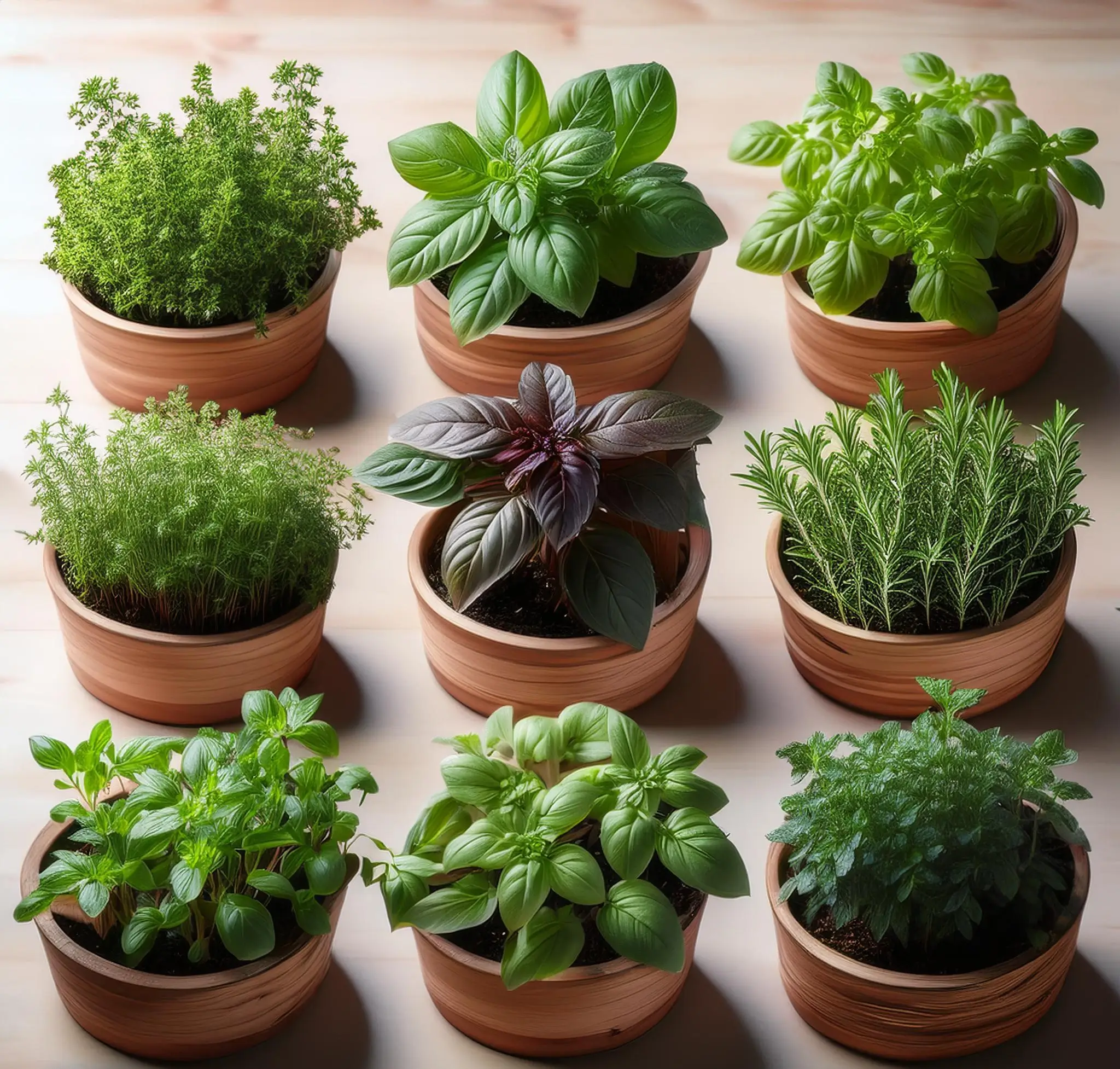
Growing herbs at home, even in limited space, is an enjoyable and rewarding hobby. Whether living in an apartment or having a small outdoor area, cultivating various fresh herbs is possible with the proper planning and techniques. This guide will walk you through how to grow multiple herbs in a small space, including selecting the right herbs, choosing containers, arranging them for optimal growth, and maintaining your home herb garden.
Why Grow Herbs at Home?
Herbs are a fantastic addition to any home garden, especially when space is premium. They’re easy to grow, require little space, and provide a fresh supply of ingredients that can elevate the flavor of your meals. Herbs provide medicinal benefits beyond culinary uses and serve as ingredients for teas, oils, and other natural remedies. Plus, many herbs are aesthetically pleasing and can enhance the beauty of your small garden or home space.
Choosing the Right Herbs for Small Spaces
When growing herbs in small spaces, it is important to choose varieties that thrive in containers or confined areas. Some herbs naturally grow compact, and you can easily prune others to fit your space.
Here are some herbs that are well-suited for small-space gardening:
- Basil: A versatile herb, perfect for salads, sauces, and garnishes. It grows well in pots and loves sunlight.
- Thyme: A low-growing, woody herb that doesn’t take up much space and pairs well with many dishes.
- Mint: overgrows and should be planted in its container to prevent it from spreading aggressively.
- Parsley: A biennial herb that is easy to grow and maintain, parsley is a popular choice for small gardens.
- Cilantro: Another easy-to-grow herb, cilantro can thrive in small pots and is frequently used in many types of cuisine.
- Chives: With a mild onion flavor, chives are perfect for small spaces and grow well in containers.
- Oregano: This herb is compact and grows well in confined spaces, making it a great addition to a small herb garden.
- Sage: Although sage can grow large, regular pruning will keep it contained in a smaller space.
- Rosemary: a fragrant herb that can grow tall but can be pruned to fit in a small container.
Selecting the Right Containers
Choosing the proper containers is critical when growing multiple herbs in a small space. You can grow herbs in individual pots, grouped in larger containers, or even in creative vertical gardens.
Here are a few container ideas:
- Individual Pots
- Terracotta pots: these are classic, breathable pots that allow water to evaporate, preventing waterlogged roots.
- Plastic pots: Lightweight and easy to move around, plastic pots come in various sizes and are great for herbs.
- Self-watering pots: Perfect for beginners, self-watering pots ensure your herbs get just the right amount of water.
- Window Boxes
- If you have a windowsill or small balcony, window boxes are ideal for growing multiple herbs in one long container. Ensure the box has proper drainage holes, and plant herbs with similar water and sunlight needs together.
- Vertical Gardens
- Vertical gardens are excellent for maximizing space. You can use vertical planters, hanging pots, or repurposed items like pallets to create a wall of herbs. These systems save floor space while providing ample room for different herbs.
- Hanging Baskets
- If you’re short on space, hanging baskets allow you to grow herbs above ground level, indoors near a sunny window, or outdoors on a porch or balcony.
Potting Mix and Drainage
When planting herbs in containers, using a high-quality, well-draining potting mix is essential. Herbs don’t do well in waterlogged soil, so you’ll want to ensure your containers have drainage holes to let excess water escape. You can also add a layer of pebbles or gravel at the bottom of each container to improve drainage.
A lightweight potting mix designed for herbs or vegetables works best. You can make your mix by combining garden soil, compost, and perlite or sand to create a light, well-draining medium.
Sunlight Requirements
Most herbs need at least 6-8 hours of sunlight daily to thrive. If you’re growing indoors, place your containers near a sunny window—south-facing windows usually provide the most light. If natural light is insufficient, consider using grow lights to supplement the sunlight, especially during winter.
Herbs like basil, rosemary, and oregano thrive in full sun, while others like mint and parsley can tolerate partial shade. To ensure optimal growth, it’s important to group herbs with similar sunlight needs together.
Watering and Feeding Your Herbs
Proper watering is crucial for growing healthy herbs in containers. Since containers can dry out more quickly than garden beds, you must frequently water your herbs, especially during hot or dry weather.
Here are some watering tips for your herb garden:
- Check the soil: Before watering, examine the top inch of soil. If it’s dry, it’s time to water. Herbs prefer slightly moist soil but should never be waterlogged.
- Water early in the day: Morning water allows the plants to absorb moisture before the day’s heat, reducing evaporation.
- Avoid overwatering: by keeping herbs like thyme, rosemary, and sage in drier conditions and watering them less frequently. Ensure the soil stays well-drained.
In terms of feeding, herbs don’t need heavy fertilization. Compost or a balanced, slow-release organic fertilizer once a month is enough to keep your plants healthy. Over-fertilizing can lead to excessive growth, which can reduce the flavor of your herbs.
Pruning and Harvesting
Pruning and harvesting herbs regularly encourages bushier growth and ensures a continuous supply of fresh herbs for your kitchen.
Here’s how to prune and harvest different herbs:
- Basil: Pinch off the top leaves to prevent flowering and encourage more leaf growth.
- Thyme and oregano: These herbs can be cut back frequently, and harvesting them promotes new growth.
- Parsley and cilantro: Harvest by cutting the outer stems first, leaving the inner stems to continue growing.
- Mint: Regularly prune mint to keep it from becoming too leggy and to prevent it from spreading uncontrollably.
- Sage and rosemary: Trim back the woody stems to promote fresh growth and prevent the plants from becoming too tall.
Remember not to remove more than one-third of the plant at a time to avoid stressing it.
Grouping Herbs Together
One of the challenges of growing multiple herbs in a small space is ensuring they all thrive despite having different needs. To make the most of your space, group herbs with similar requirements together in the same container or area.
For example:
- Mediterranean herbs like rosemary, thyme, and oregano all prefer full sun and drier soil, making them excellent companions in a single container.
- Moisture-loving herbs like basil and parsley can be grouped as they require more frequent watering.
By carefully selecting and pairing herbs based on their sunlight, water, and space needs, you can maximize your small garden and ensure all your plants flourish.
Maintaining Your Herb Garden
Once your herbs are established, regular maintenance will help them thrive throughout the growing season. Here’s how to keep your small-space herb garden healthy:
- Rotate pots for even growth: If you notice one side of the plant growing more, rotate the container to ensure sunlight exposure.
- Deadhead flowers: If your herbs begin to flower, snip off the flowers to redirect energy into growing more leaves.
- Watch for pests: Watch for common pests like aphids or spider mites. If you notice any, treat them with insecticidal soap or neem oil.
Conclusion
Growing multiple herbs in a small home space is possible and can be incredibly fulfilling. With careful planning, the proper containers, and some essential maintenance, you can cultivate various herbs that will provide fresh flavors and aromas throughout the year. Whether planting on a balcony, windowsill, or small garden bed, your home can become a thriving hub for diverse herbs. Enjoy the process of growing and harvesting, and savor the difference fresh herbs make in your cooking and daily life!

